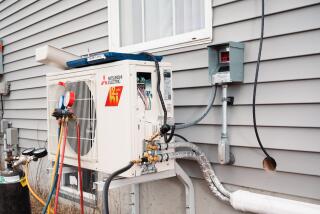Crisis Produces Some New Believers in Conservation
- Share via
BERKELEY — David Osborne is watching an anxious new breed of customer wander into his energy conservation hardware store.
They’re the armies of former nonbelievers--the homeowners and apartment dwellers who always figured that saving energy was a tedious job that belonged to somebody else.
But now, with the prospect of skyrocketing power bills and stories of temporary blackouts in hand, they’re looking for ways to loosen what they regard as their power company’s malevolent grip over their lives.
“Many are downright angry,” said Osborne, manager of Real Goods Trading Corp., which sells a host of products for energy-efficient living. “Along with some sky-high electrical bills have come some hard lessons--that cheap electricity isn’t a right, it’s a luxury, and that PG&E; isn’t going to be there for them 24/7.” Sales are up 15%.
Each day, Osborne, 35, and his staff at Real Goods offer impromptu educational sessions for customers seeking to draw the line on unchecked energy bills.
They demonstrate the long-term savings of such renewable energy products as solar-powered heating systems, on-demand water heaters, rechargeable batteries, hand-cranked flashlights and radios, even things as simple as compact fluorescent lightbulbs.
They preach their energy-saving tips mostly to middle-class homeowners, most of whom could afford to pay $600 or more for a new water heater or energy-efficient refrigerator.
Many of Osborne’s middle-class customers have yet to get religion: They’re not looking for ways to conserve energy, just a way to pay less for consumption habits they’re finding difficult to break.
Others express sticker shock at the high start-up cost of conserving, wincing at paying $20 for a watt-stingy lightbulb. Or assuming “they can just throw up a few solar panels at 30 bucks a pop,” rather than paying the going rate of $500 or more.
“Like with the compact fluorescent lightbulbs, I explain that these things only look expensive,” says Osborne, who with his ponytail, jeans and soft-spoken delivery resembles an aging UC Berkeley graduate student. “The truth is that they use only one-fifth the power and burn five times as long. Like most things that are energy renewable, they eventually pay for themselves.”
Osborne says he considers it a good day “if I can show someone how they’re just throwing energy away by doing things the old way. I try to demonstrate just how wasteful the average home is.”
One good example: that 20-year-old water heater.
Osborne points to new heaters that warm water only when needed. “Studies show people spend 50% of their energy bill heating their water,” he said. “Why keep 30 to 80 gallons at 120 degrees all the time? It makes absolutely no sense, but nearly everyone does it.”
For renters whose landlords refuse to insulate drafty apartments, Osborne sells $90 rolls of aluminum fabric that can be installed in attics at a much lower cost than fiberglass.
And for those looking to make a minor energy-saving statement, he sells hand-powered radios that can play up to an hour with one quick windup.
The trick, he says, is convincing consumers that conserving energy can be a rewarding way of life, not just a short-term sacrifice while they wait for their energy bills to return to normal.
“Even with something as simple as a lightbulb, for me there’s no better feeling than to have a customer come back and say, ‘Gee, you were right.’ That really makes my day.”
More to Read
Inside the business of entertainment
The Wide Shot brings you news, analysis and insights on everything from streaming wars to production — and what it all means for the future.
You may occasionally receive promotional content from the Los Angeles Times.











